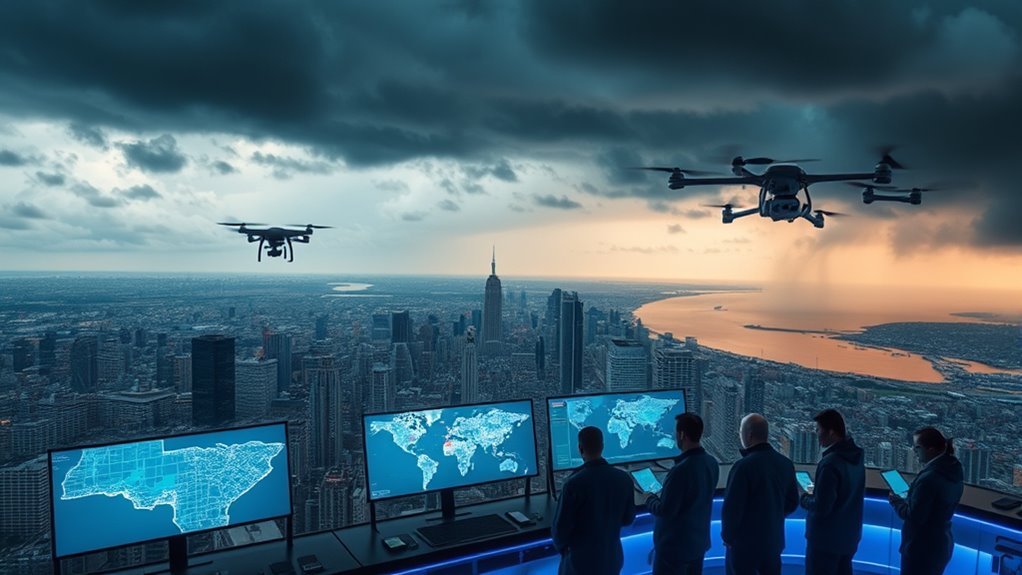You can use AI in disaster response to improve early warnings by analyzing real-time data from satellites and social media, boosting prediction accuracy and reducing false alarms. Machine learning helps allocate resources efficiently by forecasting urgent aid needs, while AI-driven damage assessment speeds up disaster impact analysis. Coordinating rescue operations benefits from AI through better communication and faster response times. Though powerful, these technologies raise ethical challenges that require careful management to guarantee fairness. Exploring these facets reveals how AI transforms disaster management.
The Role of AI in Early Warning Systems

Although traditional early warning systems have saved countless lives, AI considerably enhances their accuracy and timeliness by analyzing vast datasets in real time. You benefit directly from AI’s ability to integrate diverse data sources—satellite imagery, sensor readings, social media feeds—into a cohesive framework. Predictive analytics then processes this integrated data, identifying subtle patterns and forecasting disaster events with greater precision. This means earlier alerts and more actionable insights, giving you vital extra time to prepare or evacuate. The integration of AI reduces false alarms and improves confidence in warnings, empowering you to make informed decisions swiftly. Fundamentally, AI’s role in early warning systems transforms raw data into reliable foresight, aligning with your desire for autonomy and control in the face of unpredictable natural threats.
Enhancing Resource Allocation With Machine Learning

When disasters strike, efficiently allocating resources can mean the difference between containment and catastrophe. By leveraging machine learning, you gain access to powerful tools for resource optimization that analyze vast datasets to predict where aid is most urgently needed. Predictive analytics enable you to anticipate demand spikes, directing supplies and personnel proactively rather than reactively. This data-driven approach minimizes waste and maximizes impact, ensuring freedom from bureaucratic delays. Machine learning models continuously refine their accuracy as they process real-time inputs, allowing you to adapt allocation strategies dynamically. By integrating these technologies, you’re not just responding to disasters—you’re staying ahead of them, empowering communities to recover faster with fewer resources, and ultimately preserving lives and infrastructure with precision and efficiency. Regularly testing and updating your disaster recovery plans ensures these AI-driven strategies remain effective and aligned with evolving risks.
Real-Time Damage Assessment and Analysis

Since timely information is essential during disasters, real-time damage assessment leverages AI to rapidly analyze data from satellites, drones, and sensors. You can rely on advanced image recognition algorithms to perform accurate damage evaluation, identifying affected structures and infrastructure within minutes. This data-driven approach eliminates delays caused by manual inspections and enables swift situational awareness. By processing high-resolution imagery and sensor inputs, AI quantifies the extent of destruction, prioritizing areas that need immediate attention. This empowers you to make informed decisions without waiting for incomplete reports. Real-time analysis not only accelerates response but also enhances transparency and accountability by providing objective, consistent damage metrics. Ultimately, AI-driven damage assessment grants you greater freedom to allocate resources effectively and adapt strategies dynamically in the chaotic environment following a disaster. Incorporating automated backup processes into this system ensures that critical data is reliably preserved and readily available for continuous disaster response efforts.
Coordinating Rescue Operations Using AI Technologies
While disaster scenarios are often chaotic, coordinating rescue operations through AI technologies sharply improves efficiency and outcomes. You can leverage AI communication tools to enhance rescue team collaboration, ensuring real-time data sharing and decision-making. These tools integrate geospatial data, victim locations, and resource availability, enabling you to allocate assets precisely where needed. Studies show AI-driven coordination can reduce response times by up to 30%, directly impacting survival rates. By automating routine communication and updates, you free your team to focus on critical tasks, maintaining operational agility. Additionally, AI algorithms can predict evolving hazards, allowing you to adjust strategies dynamically. Embracing AI for rescue coordination not only streamlines processes but also empowers your team with timely, actionable intelligence, ultimately saving lives and optimizing disaster response efforts. Implementing load balancing techniques ensures that communication and data flow remain uninterrupted even under heavy network demand during disaster response.
Challenges and Ethical Considerations in AI-Driven Disaster Management
Although AI offers powerful tools for disaster management, it also brings significant challenges and ethical concerns that you must address. One critical issue is bias mitigation; AI models trained on incomplete or skewed data can perpetuate inequalities, disadvantaging vulnerable populations during crises. You’ll need transparent algorithms and diverse datasets to minimize this risk. Additionally, data privacy is paramount—collecting sensitive information for predictive modeling can expose individuals to surveillance or misuse if not handled securely. Balancing rapid response with respect for personal freedoms requires stringent data governance and ethical frameworks. To truly harness AI’s potential in disaster scenarios, you must prioritize fairness, accountability, and privacy, ensuring technology empowers all communities without sacrificing fundamental rights or amplifying existing disparities. Implementing privacy by design principles helps ensure data minimization and consent throughout AI development and deployment.



